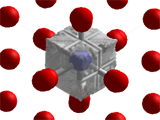Bader charge analysis of NaCl
Last Update:2021/12/09
There are many possible ways to partition the total electron density into contributions from each atom. One popular method is Bader partitioning, where the electron density is divided at zero flux surfaces. A merit in the Bader partitioning method is that in comparison to Mulliken analysis, which is another popular method, the results depend little on the employed basis set. Here, we will walk through the process of performing Bader charge analysis on NaCl crystal using Quantum Espresso. The following procedure has been tested on MateriApps Live! 2.4.
Installation of bader
Quantum Espresso comes preinstalled in MateriApps Live!. However, we will need to download the bader program from Henkelman Group’s web site:
$ wget http://theory.cm.utexas.edu/henkelman/code/bader/download/bader_lnx_64.tar.gz $ tar xzvf bader_lnx_64.tar.gz $ mv bader ~/bin
Self consistent calculation of electron density using Quantum Espresso
We will analyze results obtained using Quantum Espresso. Let’s create an input file for self-consistent calculation and name it “NaCl.scf.in”.
&control
calculation = 'scf'
prefix = 'NaCl'
pseudo_dir = './'
wf_collect = .true.
/
&system
ibrav = 2
celldm(1) = 10.66
nat = 2
ntyp = 2
ecutwfc = 60
ecutrho = 244
/
&electrons
mixing_mode = 'plain'
mixing_beta = 0.7
conv_thr = 1.0d-8
/
ATOMIC_SPECIES
Na 1 Na.pbesol-spn-kjpaw_psl.1.0.0.UPF
Cl 1 Cl.pbesol-n-kjpaw_psl.1.0.0.UPF
ATOMIC_POSITIONS
Na 0.00 0.00 0.00
Cl 0.5 0.5 0.5
K_POINTS {automatic}
8 8 8 0 0 0
We use the following PBEsol pseudopotentials from the Quantum Espresso pslibrary:
- Cl: https://www.quantum-espresso.org/upf_files/Cl.pbesol-n-kjpaw_psl.1.0.0.UPF
- Na: https://www.quantum-espresso.org/upf_files/Na.pbesol-spn-kjpaw_psl.1.0.0.UPF
They can be downloaded to the current directory as
$ wget https://www.quantum-espresso.org/upf_files/Cl.pbesol-n-kjpaw_psl.1.0.0.UPF $ wget https://www.quantum-espresso.org/upf_files/Na.pbesol-spn-kjpaw_psl.1.0.0.UPF
Now run Quantum Espresso as
$ pw.x < NaCl.scf.in > NaCl.scf.out
Post-processing to obtain cube files containing density data on a 3D mesh
Once that’s successfully done, we need to convert Quantum Espresso output to electron density files that are readable by bader. This can be achieved by pp.x (post processing) utility provided with the Quantum Espresso package. To perform the Bader partitioning, we need to prepare both the all-electron density and the valence electron density (an explanation can be found here or here). Here are the input files for the valence density (let’s name this NaCl_val.pp.in):
&inputpp
prefix = 'NaCl'
outdir = './'
filplot = 'NaCl_valence'
plot_num= 0
/
&plot
nfile = 1
iflag = 3
output_format = 6
fileout = 'NaCl_valence.cube'
/
and all-electron density (NaCl_all.pp.in):
&inputpp
prefix = 'NaCl'
outdir = './'
filplot = 'NaCl_allelec'
plot_num= 21
/
&plot
nfile = 1
iflag = 3
output_format = 6
fileout = 'NaCl_allelec.cube'
/
Make sure you have an empty newline at the end of each file. Otherwise pp.x will be unable to parse the input and will terminate with error. The most important difference between the two input files in our case is the plot_num line which specifies the physical quantities (all-electron or valence densities) that are written to the fileout file (the manual describing all options can be found here). The pp.x can be run as follows:
$ pp.x < NaCl_val.pp.in > NaCl_val.pp.out $ pp.x < NaCl_all.pp.in > NaCl_all.pp.out
Bader charge analysis
Now we can perform Bader partitioning on the .cube files created by pp.x:
$ bader NaCl_valence.cube -ref NaCl_allelec.cube
The Bader charges on each atom is contained in the ACF.dat file which should look similar to the following:
# X Y Z CHARGE MIN DIST ATOMIC VOL
--------------------------------------------------------------------------------
1 -10.660000 10.660000 10.660000 8.140837 1.940149 64.992061
2 -5.330000 5.330000 5.330000 7.859147 2.931500 237.846813
--------------------------------------------------------------------------------
VACUUM CHARGE: 0.0000
VACUUM VOLUME: 0.0000
NUMBER OF ELECTRONS: 16.0000
This shows that out of 16 valence electrons, 8.14 is assigned to Na and 7.86 to Cl. To convert this to ionic charge, we will need to check the number of electrons that are fixed in the core. This can be achieved by looking at these lines in the pseudopotential files for Na
Valence configuration:
nl pn l occ Rcut Rcut US E pseu
2S 1 0 2.00 1.000 1.250 -4.158089
3S 2 0 1.00 1.000 1.250 -0.198813
2P 2 1 6.00 0.900 1.300 -2.106125
and Cl
Valence configuration:
nl pn l occ Rcut Rcut US E pseu
3S 1 0 2.00 1.200 1.600 -1.515413
3P 2 1 5.00 1.300 1.600 -0.629258
The Na pseudopotential indicates that two 1s electrons are fixed to the core, while the Cl pseudopotential indicates that two 1s, two 2s, and six 2p electrons are fixed to the core. From this, we can calculate the total electron number on Na as (2 + 8.14) = 10.14 and on Cl as (2 + 2 + 6 + 7.86) = 17.86. By subtracting these values from the atomic numbers for Na (11) and Cl (17), we arrive at Bader charge-based ionic charge states of Na0.86+ and Cl0.86-. This is slightly smaller than the nominal ionic valences of ± 1, and indicates that there is some covalent character even in a system like NaCl which is considered a prototypical ionic crystal.

